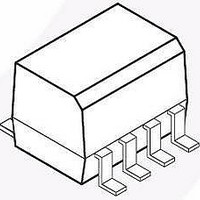FAN7930CMX Fairchild Semiconductor, FAN7930CMX Datasheet - Page 13

FAN7930CMX
Manufacturer Part Number
FAN7930CMX
Description
Power Factor Correction ICs Critical Conduction Mode PFC Controller
Manufacturer
Fairchild Semiconductor
Datasheet
1.FAN7930CMX.pdf
(22 pages)
Specifications of FAN7930CMX
Switching Frequency
300 KHz
Maximum Operating Temperature
+ 125 C
Mounting Style
SMD/SMT
Minimum Operating Temperature
- 40 C
Package / Case
SOP-8
Lead Free Status / RoHS Status
Lead free / RoHS Compliant
Available stocks
Company
Part Number
Manufacturer
Quantity
Price
Company:
Part Number:
FAN7930CMX
Manufacturer:
FSC
Quantity:
1 900
Part Number:
FAN7930CMX
Manufacturer:
FAIRCHILD/仙童
Quantity:
20 000
Part Number:
FAN7930CMX-G
Manufacturer:
ON/安森美
Quantity:
20 000
© 2010 Fairchild Semiconductor Corporation
FAN7930C • Rev. 1.0.0
valley position of MOSFET voltage stress. For valley
detection, a minor delay by the resistor and capacitor is
needed. A capacitor increases the noise immunity at the
ZCD pin. If ZCD voltage is higher than 1.5V, an internal
ZCD comparator output becomes HIGH and LOW when
the ZCD goes below 1.4V. At the falling edge of
comparator output, internal logic turns on the MOSFET.
When no ZCD signal is available, the PFC controller
cannot turn on the MOSFET, so the controller checks
every switching off time and forces MOSFET turn on
when the off time is longer than 150μs. This is called the
restart timer, which triggers MOSFET turn-on at startup
and may be used at the input voltage zero-cross period.
Because the MOSFET turn-on depends on the ZCD
input, switching frequency may increase to higher than
several megahertz due to the miss-triggering or noise
on the nearby ZCD pin. If the switching frequency is
higher than needed for critical conduction mode (CRM),
operation mode shifts to continuous conduction mode
(CCM). In CCM, unlike CRM where the boost inductor
Figure 29.
150
Figure 30.
μ
s
Auxiliary Voltage Threshold
Restart Timer at Startup
13
current is reset to zero at the next switch on; inductor
current builds up at every switching cycle and can be
raised to very high current that exceeds the current
rating of the power switch or diode. This can seriously
damage the power switch and result in burn down. To
avoid this, maximum switching frequency limitation is
embedded. If ZCD signal is applied again within 3.3μs
after the previous rising edge of gate signal, this signal
is ignored internally and FAN7930C waits for another
ZCD signal. This slightly degrades the power factor
performance at light load and high input voltage.
5. Control: The scaled output is compared with the
internal reference voltage and sinking or sourcing
current is generated from the COMP pin by the
transconductance amplifier. The error amplifier output is
compared with the internal sawtooth waveform to give
proper turn-on time based on the controller.
Unlike a conventional voltage-mode PWM controller,
FAN7930C turns on the MOSFET at the falling edge of
ZCD signal. On-instance is determined by the external
signal and the turn-on time lasts until the error amplifier
output (V
load is heavy, output voltage decreases, scaled output
decreases, COMP voltage increases to compensate low
output, turn-on time lengthens to give more inductor
turn-on time, and increased inductor current raises the
output voltage. This is how PFC negative feedback
controller regulates output.
The maximum of V
the maximum turn-on time, and switching stops when
V
COMP
Figure 31.
is lower than 1.0V.
COMP
Figure 32.
) and sawtooth waveform meet. When
Maximum Switching Frequency
COMP
is limited to 6.5V, which dictates
Limit Operation
Control Circuit
www.fairchildsemi.com












